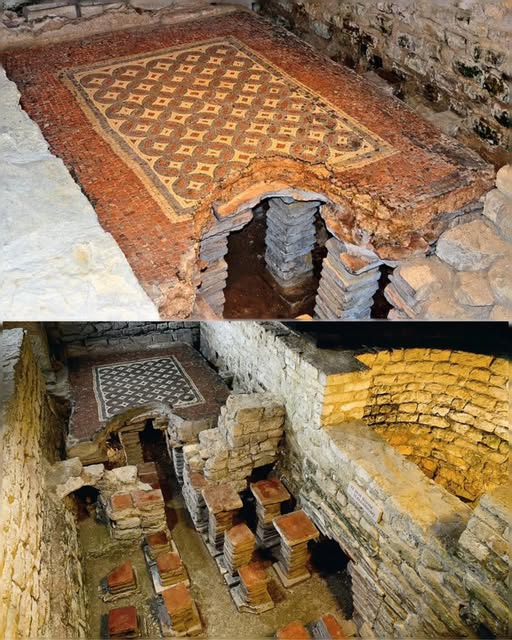Tucked away in the rolling Cotswold Hills of Gloucestershire is a site that offers more than just historical intrigue—it offers a glimpse into the refined lifestyle and engineering brilliance of ancient Rome. Chedworth Roman Villa, constructed around 120 CE, is a testament to how the Roman Empire combined luxury, practicality, and spiritual depth in its architecture and daily life. While centuries have passed, the site still resonates with stories of innovation, cultural fusion, and the enduring impact of Roman civilization in Britain.

Chedworth Roman Villa wasn’t just a grand home for a wealthy Roman-British family—it was strategically built in a location that made it a significant cultural and economic node during the Roman occupation of Britain. Situated close to the gently flowing River Coln and just off the Fosse Way, one of the major Roman roads connecting the southwest of England to Lincoln, the villa enjoyed easy access to trade, communication, and commerce. Its proximity to Corinium Dobunnorum, now known as Cirencester and once one of the largest towns in Roman Britain, shows that its owners were keenly aware of geography’s role in status and influence. This wasn’t just a house—it was a statement of power, education, and connectivity within the Roman world.
From an architectural standpoint, Chedworth Villa is nothing short of groundbreaking. One of its most impressive features is the hypocaust system—a form of central heating that still sparks admiration today. The Romans designed this system to distribute warm air under floors and through flues in the walls, providing consistent and efficient heating throughout the structure. The genius of this system lies in its simplicity and effectiveness, a remarkable feat of ancient engineering. The bathhouses at Chedworth were equipped with both steam and dry heat facilities, showcasing a level of comfort and technological sophistication that rivaled anything found in major Roman cities like Rome or Pompeii. These spaces weren’t merely functional; they reflected the Roman belief in cleanliness, relaxation, and social engagement as integral parts of life.
The villa’s interior tells a story of aesthetics as much as it does of utility. As visitors walk through the remaining 15 rooms of the complex, they find themselves literally stepping on Roman artistry. The mosaic floors, preserved in incredible detail, feature geometric designs and mythological scenes that speak volumes about Roman taste, symbolism, and craftsmanship. Among the most exceptional is the mosaic in Room 28, dating from the 5th century CE—a time when Roman rule had officially ended in Britain. Yet, this artwork proves that the cultural and artistic expressions of Rome were still very much alive. The motifs likely held both decorative and narrative significance, possibly telling stories that conveyed moral lessons or celebrated Roman deities, subtly reinforcing cultural values in everyday life.
Chedworth wasn’t only a place to live and entertain—it also served a deeply spiritual purpose. At the heart of the villa sits a nymphaeum, a sacred shrine constructed around a natural spring. This space was more than a decorative garden feature; it was a focal point of worship and ritual. Natural springs were often regarded by Romans as sacred, and the presence of such a shrine at Chedworth reflects the blending of Roman religious practices with local Celtic traditions. This integration reveals a broader truth about the Roman Empire: while it brought its own gods, customs, and laws, it also adapted to and embraced the local beliefs of the people it governed. In many ways, this approach helped to solidify Roman rule by creating a shared cultural and spiritual identity among diverse populations.
Perhaps the most astonishing aspect of Chedworth Villa is its continued use even after the fall of Roman authority in Britain. When the empire officially withdrew from the island in 410 CE, many Roman settlements were abandoned or fell into disrepair. Chedworth defied this trend. Archaeological evidence suggests that the villa underwent renovations and continued to be used well into the 5th century CE. This enduring occupation is a clear sign of how embedded Roman customs had become within local British life. Even without imperial oversight, the lifestyle, technologies, and traditions associated with Rome carried on—an indication of the profound cultural transformation that Roman rule had triggered.
Today, Chedworth Roman Villa is preserved and cared for by the National Trust, a stewardship that ensures its stories continue to inspire future generations. But the site is more than a static relic—it’s a dynamic educational resource that paints a vivid picture of life nearly two thousand years ago. Every meticulously laid tile, every stone corridor, and every heating duct speaks of a society that valued comfort, artistry, and innovation. Visitors don’t just walk through ruins; they walk through a legacy. They see how engineering served both function and form, how art was a language of power and belief, and how the Romans built not only with stone but with purpose and vision.
In the larger narrative of British history, Chedworth stands out as an enduring monument to Roman influence. The site challenges us to rethink what we know about ancient life—reminding us that the Romans were more than conquerors. They were builders of systems, lovers of beauty, and masters of adaptation. Their legacy in Britain, particularly at sites like Chedworth, is not one of destruction but of contribution. As you move through the preserved walkways and admire the surviving mosaics, you’re participating in a dialogue that began almost two millennia ago—a conversation about culture, identity, and the remarkable capacity of human ingenuity to bridge time.
Chedworth Roman Villa endures as a living connection to a time when Britain was a province of a sprawling empire. Its preservation invites not only admiration but reflection—on how ancient peoples lived, what they valued, and how their stories still shape our understanding of the world today.





